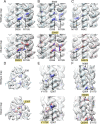Structural conservation among variants of the SARS-CoV-2 spike postfusion bundle
- PMID: 35363556
- PMCID: PMC9169775
- DOI: 10.1073/pnas.2119467119
Structural conservation among variants of the SARS-CoV-2 spike postfusion bundle
Abstract
Variants of severe acute respiratory syndrome coronavirus 2 (SARS-CoV-2) challenge currently available COVID-19 vaccines and monoclonal antibody therapies due to structural and dynamic changes of the viral spike glycoprotein (S). The heptad repeat 1 (HR1) and heptad repeat 2 (HR2) domains of S drive virus–host membrane fusion by assembly into a six-helix bundle, resulting in delivery of viral RNA into the host cell. We surveyed mutations of currently reported SARS-CoV-2 variants and selected eight mutations, including Q954H, N969K, and L981F from the Omicron variant, in the postfusion HR1HR2 bundle for functional and structural studies. We designed a molecular scaffold to determine cryogenic electron microscopy (cryo-EM) structures of HR1HR2 at 2.2–3.8 Å resolution by linking the trimeric N termini of four HR1 fragments to four trimeric C termini of the Dps4 dodecamer from Nostoc punctiforme. This molecular scaffold enables efficient sample preparation and structure determination of the HR1HR2 bundle and its mutants by single-particle cryo-EM. Our structure of the wild-type HR1HR2 bundle resolves uncertainties in previously determined structures. The mutant structures reveal side-chain positions of the mutations and their primarily local effects on the interactions between HR1 and HR2. These mutations do not alter the global architecture of the postfusion HR1HR2 bundle, suggesting that the interfaces between HR1 and HR2 are good targets for developing antiviral inhibitors that should be efficacious against all known variants of SARS-CoV-2 to date. We also note that this work paves the way for similar studies in more distantly related viruses.
Keywords: COVID-19; HR1HR2; SARS-CoV-2; cryogenic electron microscopy; membrane fusion.
Conflict of interest statement
The authors declare no competing interest.
Figures




Similar articles
-
Structure-based design of a SARS-CoV-2 Omicron-specific inhibitor.Proc Natl Acad Sci U S A. 2023 Mar 28;120(13):e2300360120. doi: 10.1073/pnas.2300360120. Epub 2023 Mar 20. Proc Natl Acad Sci U S A. 2023. PMID: 36940324 Free PMC article.
-
SARS-CoV-2 Omicron Variant Spike Glycoprotein Mutation Q954H Enhances Fusion Core Stability.ACS Chem Biol. 2025 Jul 18;20(7):1627-1634. doi: 10.1021/acschembio.5c00208. Epub 2025 Jul 6. ACS Chem Biol. 2025. PMID: 40619650
-
Nanomolar inhibition of SARS-CoV-2 infection by an unmodified peptide targeting the prehairpin intermediate of the spike protein.Proc Natl Acad Sci U S A. 2022 Oct 4;119(40):e2210990119. doi: 10.1073/pnas.2210990119. Epub 2022 Sep 19. Proc Natl Acad Sci U S A. 2022. PMID: 36122200 Free PMC article.
-
Targetable elements in SARS-CoV-2 S2 subunit for the design of pan-coronavirus fusion inhibitors and vaccines.Signal Transduct Target Ther. 2023 May 10;8(1):197. doi: 10.1038/s41392-023-01472-x. Signal Transduct Target Ther. 2023. PMID: 37164987 Free PMC article. Review.
-
Multimerization of the heptad repeat regions of the SARS-CoV 2 spike protein.Biochim Biophys Acta Biomembr. 2024 Feb;1866(2):184259. doi: 10.1016/j.bbamem.2023.184259. Epub 2023 Dec 5. Biochim Biophys Acta Biomembr. 2024. PMID: 38061554 Review.
Cited by
-
ViralVar: A Web Tool for Multilevel Visualization of SARS-CoV-2 Genomes.Viruses. 2022 Dec 5;14(12):2714. doi: 10.3390/v14122714. Viruses. 2022. PMID: 36560718 Free PMC article.
-
Towards developing a variant-proof SARS-CoV-2 vaccine.Cell Res. 2023 Jan;33(1):5-6. doi: 10.1038/s41422-022-00753-4. Cell Res. 2023. PMID: 36588119 Free PMC article. No abstract available.
-
Mutations in the SARS-CoV-2 spike receptor binding domain and their delicate balance between ACE2 affinity and antibody evasion.Protein Cell. 2024 May 28;15(6):403-418. doi: 10.1093/procel/pwae007. Protein Cell. 2024. PMID: 38442025 Free PMC article. Review.
-
Structural and pKa Estimation of the Amphipathic HR1 in SARS-CoV-2: Insights from Constant pH MD, Linear vs. Nonlinear Normal Mode Analysis.Int J Mol Sci. 2023 Nov 10;24(22):16190. doi: 10.3390/ijms242216190. Int J Mol Sci. 2023. PMID: 38003380 Free PMC article.
-
A CRISPR/Cas12a-empowered surface plasmon resonance platform for rapid and specific diagnosis of the Omicron variant of SARS-CoV-2.Natl Sci Rev. 2022 Jun 3;9(8):nwac104. doi: 10.1093/nsr/nwac104. eCollection 2022 Aug. Natl Sci Rev. 2022. PMID: 35992231 Free PMC article.
References
-
- Manzanares-Meza L. D., Medina-Contreras O., SARS-CoV-2 and influenza: A comparative overview and treatment implications. Bol. Méd. Hosp. Infant. México 77, 262–273 (2020). - PubMed
-
- Wang P., et al. , Antibody resistance of SARS-CoV-2 variants B.1.351 and B.1.1.7. Nature 593, 130–135 (2021). - PubMed
-
- Wibmer C. K., et al. , SARS-CoV-2 501Y.V2 escapes neutralization by South African COVID-19 donor plasma. Nat. Med. 27, 622–625 (2021). - PubMed
MeSH terms
Substances
Supplementary concepts
Grants and funding
LinkOut - more resources
Full Text Sources
Medical
Research Materials
Miscellaneous

